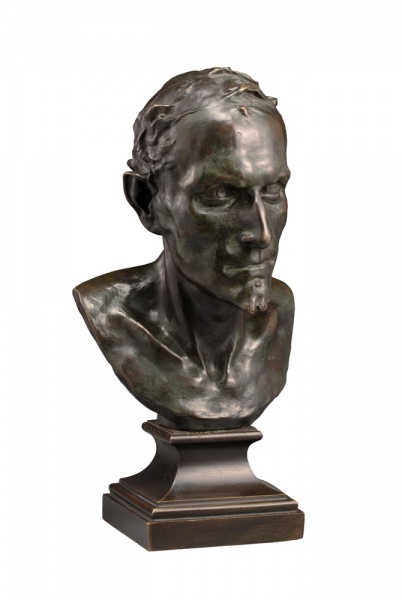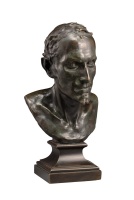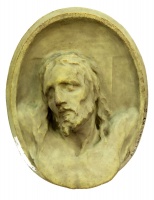

Head of Mephistopheles
| Author: | Mark Antokolsky (1843–1902) |
Mark (Mordechai) Antokolsky (b. 1842 Vilnius – d. 1902 Frankfurt am Main, buried in St Petersburg) was born into a family of seven children, Mark Antokolsky first learned the trade of a carpenter and woodcarver. Between 1862 and 1868 he studied at the Imperial Academy of Art in St Petersburg, where he was the first Jewish student. He later became the world’s first famous Jewish sculptor. From 1880 until his death, Antokolsky lived and worked almost continuously in Paris. Famous Parisian artists such as Auguste Rodin, and the entire artistic elite of Eastern Europe, visited his studio. Antokolsky became famous for his realistic sculptures of historical figures: Ivan the Terrible, Peter the Great, Ivan III on Horseback, Dying Socrates, Christ Before the Judges, etc. In 1878, his work was awarded the Grand Prix at the Paris Exposition Universelle, and in 1880 he received the title of professor. When his body was transported from Frankfurt to St Petersburg, the train stopped in Vilnius, where a crowd of people came to bid him farewell.
Source: Ellex Valiunas (LAWIN until 2015) art album: STORIES OF LITVAK ART (2023). Compiler and author Vilma Gradinskaitė.

Mark (Mordechai) Antokolsky (b. 1842 Vilnius – d. 1902 Frankfurt am Main, buried in St Petersburg) was born into a family of seven children, Mark Antokolsky first learned the trade of a carpenter and woodcarver. Between 1862 and 1868 he studied at the Imperial Academy of Art in St Petersburg, where he was the first Jewish student. He later became the world’s first famous Jewish sculptor. From 1880 until his death, Antokolsky lived and worked almost continuously in Paris. Famous Parisian artists such as Auguste Rodin, and the entire artistic elite of Eastern Europe, visited his studio. Antokolsky became famous for his realistic sculptures of historical figures: Ivan the Terrible, Peter the Great, Ivan III on Horseback, Dying Socrates, Christ Before the Judges, etc. In 1878, his work was awarded the Grand Prix at the Paris Exposition Universelle, and in 1880 he received the title of professor. When his body was transported from Frankfurt to St Petersburg, the train stopped in Vilnius, where a crowd of people came to bid him farewell.
Source: Ellex Valiunas (LAWIN until 2015) art album: STORIES OF LITVAK ART (2023). Compiler and author Vilma Gradinskaitė.







